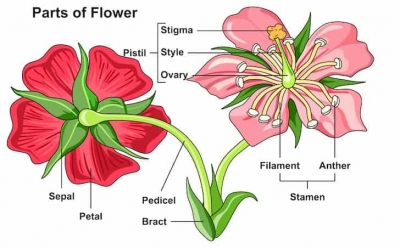
FLOWERS
Many plants produce beautiful flowers, often vividly coloured and fragrant. These intricate structures form the reproductive parts of plants and have evolved so that they attract insects and birds to sip the sugary nectar at the flower’s centre. While feeding, the insect or bird is dusted with pollen, which is produced by the stamens and contains the male sex cells. The pollen is deposited on the sticky stigma of another flower. This is pollination. A pollen tube then grows down the style to the ovary and fertilizes an ovule. This is fertilization. Some plants, such as grasses and many types of trees, rely on the wind to carry their pollen and their flowers do not need showy petals or fragrant nectar to attract animals. Since this is a less efficient system, they must produce far more pollen, which can fill the air and cause hay fever.
- Flower Structure A typical flower develops inside a bud at the end of a stalk. When the bud opens, it reveals a ring of petals, each of which secretes nectar from its base. At the centre of the flower lie the male structures that produce pollen. These surround the female structures that hold the ovules, or egg cells. An outer ring of green sepals may protect the flower when it is in bud.
- Carpel An ovary, a style, and a stigma form the main parts of a carpel. At the heart of the flower lie the ovules, enclosed in a case called an ovary. The top of each ovary extends into a style that carries a sticky pad called a stigma. The flowers of some plants have man carpels, each with their own stigma, but this lily has just one.
- Stamen The tiny, dust-like pollen grains that contain the male cells are produced by stamens. These usually form a ring around the central carpel or carpels. Each stamen has a long filament, which supports a club-like anther that produces the pollen.
- Transferring Pollen Insects such as butterflies often drink nectar from one type of flower. Hummingbirds do the same, because their bills are the right shape to reach the nectar. The bird and the insect get dusted with pollen in the process, and carry it directly to another flower of the same type.
- Fertilization If a hummingbird sips nectar from this lily, it will pickup pollen on its breast feathers. If the bird visits another lily, the sticky central stigma may pick up the pollen. Each pollen grain then sprouts a long tube that grows down through the carpel to reach an ovule. The male cell moves down the tube to fertilize the ovule so it can develop into a seed.
Picture Credit : Google




